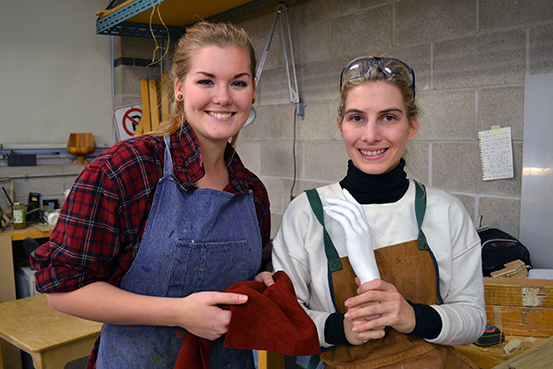Food for Thought exhibit gets students involved

Jessica Trotter, a third-year Textile student, and Natalie Sirianni, a first-year Furniture student, put together their food project in the woodshop.
STORY BY ELISE MORTON
PHOTOS BY ELISE MORTON
Excitement filled Sheridan’s crowded Marquee Friday as students in the Bachelor of Craft and Design program competed for the opportunity to have their work displayed in a Toronto gallery as a part of the Food for Thought exhibit.
According to Peter Fleming, a studio head and professor in the furniture program, only half of the 18 group projects will be featured at the Hilditch Architects Gallery, located at 401 Richmond St. West, Toronto. Usually, the artwork is displayed at Sheridan’s own gallery, but it was fully booked, creating a unique opportunity.
Food for Thought was a special project where groups consisting of nine to 10 students were given one week to develop and creatively explain a food-related design idea.
In 2013, Sheridan ran a similar project called “Shed” where students created projects and concepts related to light, which were featured in a gallery during the Toronto Design Offsite Festival. These unique projects gave students a chance to display their talents and work as a team and create a greater public awareness by displaying Sheridan’s creativity at work.
Collaboration plays a large role in design, as many mediums must work together.
“It gives students the opportunity to professionally practice collaboration meaningfully before they go into work,” said Fleming. “One of the most important things when they work is collaborating with designers and gallery owners to put together projects bigger than themselves.”
More than 50 people were jammed into the packed Marquee to take in the Sheridan teams’ work. They were all very impressed by the creativity and practicality of the projects.
One project that caught the attention of visitors was the “Health & Hands” vending machine, which dispensed all healthy, non-genetically modified organic foods. During the two hours of the presentation, the machine dispensed $35 of product.
“Our goal is to get a real life version of the vending machine placed in Sheridan,” said Charlotte Gloin, a first-year Glass student. “As an experiment we might leave it next to the traditional machines for a week in the AA Wing to get reactions from people.”
There was an interactive game that students had developed based on the childhood game hungry hungry hippos, called “Cuplander”. The objective was to collect the most colourful balls with different sized cups. To illustrate the barriers of poorer countries accessibility to food resources, players with shorter straps and smaller cups collected fewer balls whereas the players with the longer or stretchy straps collected the most.
“The project inspires students to work in teams, see the other studios and stimulates expanding their horizons into different zones,” said Koen Vanderstukken, a studio head and professor in the Glass program. “It gets them to see the other areas because usually they are only in their own studios.”




